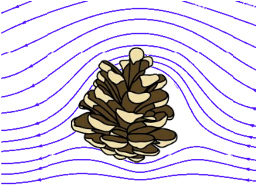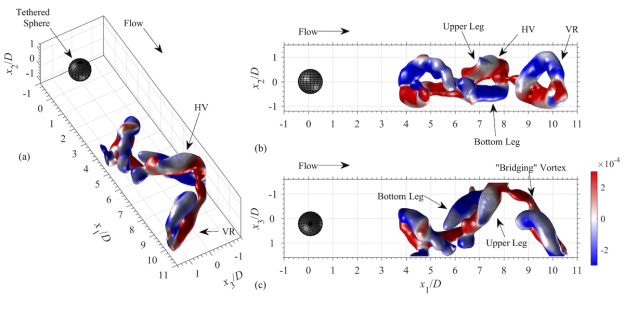Despite the fact that a tethered bluff body is a configuration commonly occurring in engineering applications (e.g. blimps, ocean buoys) as well as in nature (e.g. seed or pollen dispersal by plants), the study of tethered spheres exposed to uniform flow was only initiated about fifteen years ago by the group headed by Prof. C. Williamson at Cornell University when they showed that tethered spheres experienced large amplitude, transverse oscillations similar to VIV of tethered cylinders. Obtained peak to peak amplitudes were comparable to the sphere’s diameter. Since then studies have identified multiple oscillation modes with increasing reduced velocity, U*= U/fND,where fN is the natural frequency of the pendulum. Modes included highly periodic ones at relatively small U* (“lock-in”) and additional non-stationary modes with large oscillation amplitudes at increasing U*. The amplitude response and distinction between the different modes depends on the mass parameter defined as the ratio between the sphere’s mass and the mass of the displaced fluid, m*= ms/mf, as well as on the mass damping parameter, M* = (m* + CA)ζ, where CA is the added mass parameter for a sphere and ζ is the damping factor. Fluid-structure interactions can be both desirable, e.g. energy harvesting techniques and detrimental in the case f “locks” onto the structure’s natural frequency, possibly leading to structural damage. Most research on fluid-structure interaction has been focused on cylinders where the wake flow is quasi two-dimensional (2D).
The research objectives:
- Measurement of the 3D wake structure of a tethered sphere over a range of Reynolds numbers and mass parameters.
- Determination of the fluid forcing acting on the tethered sphere using the measured 3D flow fields. This will provide insight into the relevant energy transfer mechanisms between fluid and sphere.
Students working on the project: Daniel Kovalev (MSc), Lior Eshbal (PhD)
Students that finished: Alexander Krakovich (MSc), Lior Eshbal (MSc)
This research was funded by the Israel Science Foundation under grant number: 1596/14

